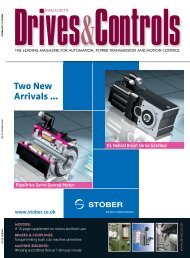New Danfoss VLT® Decentral Drive E cient, reliable and powerful
New Danfoss VLT® Decentral Drive E cient, reliable and powerful
New Danfoss VLT® Decentral Drive E cient, reliable and powerful
Create successful ePaper yourself
Turn your PDF publications into a flip-book with our unique Google optimized e-Paper software.
LINEAR MOTION<br />
Museum’s 4D ride<br />
has added muscle<br />
Visitors to Manchester Museum of<br />
Science <strong>and</strong> Industry can now<br />
experience a “four-dimensional”<br />
immersive ride, during which their seats<br />
are moved by a novel form of pneumatic<br />
linear actuator. The 4D Theatre’s seats<br />
subject their occupants to a variety of<br />
movements, synchronised to the film<br />
being shown, along with special effects<br />
including water sprays <strong>and</strong> air blasts.<br />
The ride has been developed by<br />
Simworx, a specialist developer of 4D<br />
effects theatres <strong>and</strong> simulation attractions,<br />
based in Kingswinford, West Midl<strong>and</strong>s.<br />
The company is a world leader in<br />
designing <strong>and</strong> manufacturing stationary<br />
<strong>and</strong> mobile 4D effects theatres <strong>and</strong><br />
simulation attractions, with more than 600<br />
installations worldwide at sites including<br />
aeronautical <strong>and</strong> science museums in the<br />
UK <strong>and</strong> US, <strong>and</strong> theme parks in Europe.<br />
The seats for Simworx' latest<br />
Dimensions theatres are based on a<br />
modular design, with all of the motion<br />
actuators incorporated in a shallow, floorst<strong>and</strong>ing<br />
plinth that supports four seats.<br />
The most sophisticated models offer<br />
forwards/backwards <strong>and</strong> left/right tilting<br />
movements, as well as vertical drops. The<br />
headrest of each seat can be fitted with<br />
optional water sprays <strong>and</strong> air blasts, <strong>and</strong><br />
the pedestal can be fitted with a<br />
pneumatically-powered leg tickler.<br />
Over the years, Simworx has used<br />
various actuators from different suppliers<br />
to achieve its dynamic effects. Most have<br />
been pneumatic, because this is a safe,<br />
cost-effective technology which offers a<br />
higher power density than electric<br />
actuators, making it easier to integrate<br />
into the body of the seat.<br />
While developing its latest seats,<br />
Simworx became aware of Festo's “fluidic<br />
muscle” technology – a unique form of<br />
tensile pneumatic actuator which mimics<br />
biological muscles by contracting when<br />
fed with compressed air. These actuators<br />
are capable of fast, smooth operation, as<br />
well as slow, jolt-free movements, <strong>and</strong> can<br />
generate an initial force about ten times<br />
higher than a conventional pneumatic<br />
actuator of a similar diameter.<br />
According to Simworx director, Andy<br />
Roberts, when he first saw fluidic muscles<br />
being demonstrated, “it was immediately<br />
apparent that the muscles are considerably<br />
better than conventional pneumatic<br />
actuators for simulator-type applications<br />
like ours. They provide excellent dynamic<br />
performance, <strong>and</strong> have a much higher<br />
power density.”<br />
Simworx is using the most <strong>powerful</strong>,<br />
40mm-diameter versions of Festo's latest<br />
DMSP series fluidic muscles for its new<br />
seats. The muscles use press-fit<br />
connections to minimise size <strong>and</strong> weight.<br />
Each four-seat plinth module contains four<br />
fluidic muscles – one in each corner –<br />
together with four manifold-mounted<br />
Festo VPPM proportional pressure<br />
regulators, <strong>and</strong> a controller. The cascaded<br />
dual-stage regulators provide an easy,<br />
precise means of varying flow rates to the<br />
actuators. To minimise noise interference,<br />
the compressed air supply is generated<br />
outside the theatre <strong>and</strong> is distributed to<br />
each seat module via a “pneumatic ring<br />
main”. The exhausted air is released<br />
locally, via silencers.<br />
The controller in each seat module<br />
communicates with a host control PC via a<br />
fieldbus system. Special event triggers in<br />
the film being shown instruct the central<br />
controller to issue appropriate signals to all<br />
of the seat modules in the theatre<br />
simultaneously, resulting in the entire<br />
audience experiencing exactly the same<br />
effect – be it pitch, rock, vibrate or a<br />
The theatre’s seats incorporate<br />
<strong>powerful</strong> “fluidic muscles”<br />
in a shallow floor-st<strong>and</strong>ing plinth<br />
sudden drop – at the same time.<br />
Following the Manchester museum<br />
installation, Simworx is supplying a<br />
Dimensions system for an indoor theme<br />
park on Weston-super-Mare's newly<br />
rebuilt Gr<strong>and</strong> Pier. “I envisage we'll be<br />
making increasing use of this technology<br />
in the future,” says Roberts. D&C<br />
www.drives.co.uk November/December 2010 23




